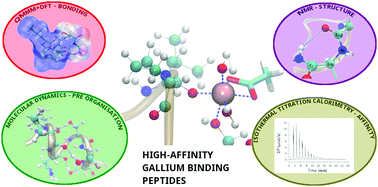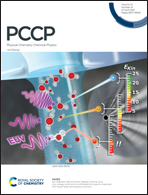Investigation of the structure and dynamics of gallium binding to high-affinity peptides elucidated by multi-scale simulation, quantum chemistry, NMR and ITC†
Abstract
Gallium (as Ga3+) is a Group IIIa metal and its recovery from wastewaters has become increasingly important for its reuse. The use of peptides for recycling offers a low-cost and environmentally-friendly option but the structural characteristics of peptides likely to bind Ga3+ are largely unknown. Multiple computational methods, coupled with experimental verification via NMR and Isothermal Calorimetry (ITC), were used to establish that Ga3+ binds with high affinity to peptide sequences and to elucidate the structural characteristics that contributed. It was demonstrated that peptide pre-organisation is key to Ga3+ binding and that a favourable binding position is necessarily governed by the size and shape of the electrostatic environment as much as individual electrostatic interactions with peptide residues themselves. Given favourable conditions, Ga3+ retrieved plausible binding positions involving both charged and uncharged residues that greatly increases the range of bonding possibilities with other peptide sequences and offers insights for binding other metals. The addition of pH buffer substantially improved the affinity of Ga3+ and a structural role for a buffer component was demonstrated.



 Please wait while we load your content...
Please wait while we load your content...